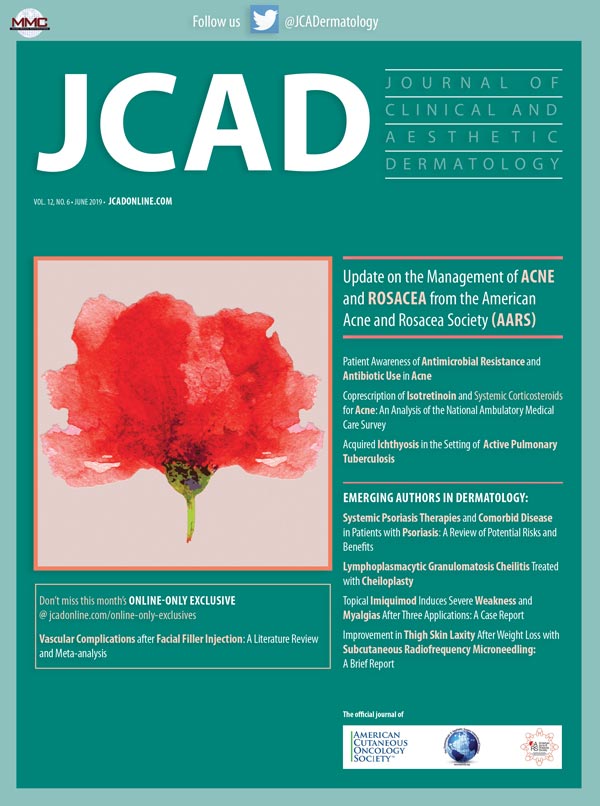VOL. 12, NO. 6 • JUNE 2019
 Dear Colleagues:
Dear Colleagues:
Welcome to the June 2019 issue of The Journal of Clinical and Aesthetic Dermatology (JCAD). In this issue, we are pleased to present the article “Update on the Management of Rosacea from the American Acne & Rosacea Society (AARS),” by Del Rosso, Tanghetti, Webster, Stein Gold, Thiboutot, and Gallo. This article updates the previously published consensus recommendations from the AARS on the management of rosacea, including discussions of available published data on topical ivermectin, topical oxymetazoline, combination therapy approaches, and physical therapeutic devices for the management of rosacea. Consistent with what many publications on rosacea currently emphasize, the authors encourage clinicians to define the clinical manifestations of rosacea in the patient at presentation and to “select therapies that correlate with the optimal treatment of those manifestations.”
Next, Vasicek et al present the results of their survey analysis in the article titled, “” Here, the investigators sought to quantify the estimated frequency of coprescription of isotretinoin and systemic corticosteroids in acne and assess trends as they relate to age, sex, race, insurance, and provider specialty. The results indicate that coprescription of isotretinoin and systemic corticosteroids is very rare, and the authors postulate that this might be because “either many physicians are not experiencing the paradoxical acne flare previously reported in the literature, are initiating low-dose isotretinoin to minimize the risk of a flare, are decreasing the dose of isotretinoin in response to a flare, or are unaware of the utility of the coprescription of systemic corticosteroids with isotretinoin. “
Following this, investigators sought to determine the level of awareness among adult patients with acne vulgaris (AV) and among parents of children/adolescents with AV, with regard to antibiotic resistance. In the article, “Patient Awareness of Antimicrobial Resistance and Antibiotic Use in Acne Vulgaris,” by Del Rosso et al, the authors utilized results of an online survey for their analysis. The analysis revealed that patients with AV and parents of children/adolescents with AV have a general understanding of the risks and potential causes of antibiotic resistance. The majority of those surveyed also indicated that they were not aware of antibiotic-free treatment options for AV, but were open to using them, provided they were effective. The authors close their analysis stating, “This study highlights an existing desire among patients with AV for more information from their clinicians about antibiotic resistance risk and alternative AV therapies.”
Next, in a case report titled, “Acquired Ichthyosis in the Setting of Active Pulmonary Tuberculosis,” by Liang et al, the authors describe a case of a 35-year-old woman with active pulmonary tuberculosis and a history of breast cancer who presented with a several-month history of a widespread, scaly, pruritic skin eruption. The clinical features, diagnostic methods, and treatment modalities of acquired ichthyosis associated with underlying systemic disease, particularly infection, are discussed.
Following this, we are pleased to present four articles as part of our bi-annual “Emerging Authors in Dermatology” series. In a review article titled, “Systemic Psoriasis Therapies and Comorbid Disease in Patients with Psoriasis: A Review of Potential Risks and Benefits,” by Mikhaylov et al, the authors describe and discuss studies of psoriasis treatments and their level of evidence for use in co-occurring diseases. In a case report titled, “Lymphoplasmacytic Granulomatosis Cheilitis Treated with Cheiloplasty,” Oiyemhonlan et al present a case of long-standing idiopathic orofacial granulomatous (OFG) in a 65-year-old African-American man. In a case report titled, “Topical Imiquimod Induces Severe Weakness and Myalgias After Three Applications: A Case Report,” by Pasadyn and Cain, the authors describe a patient who developed severe muscle weakness and the inability to walk following use of topical imiquimod 5% cream for three days. And finally, in a case study by Yu et al titled, “Subcutaneous Radiofrequency Microneedling for the Treatment of Thigh Skin Laxity Caused by Weight Loss: A Case Study,” the authors evaluate the use of RF in combination with microneedling to nonsurgically improve skin laxity caused by significant weight loss on the thighs of a 39-year-old woman.
Also, don’t miss this month’s Online-only Exclusive article titled, “Vascular Complications after Facial Filler Injection: A Literature Review and Meta-analysis,” by Sito, Manzoni, and Sommariva, which can be accessed here: jcadonline.com/online-only-exclusives. In this article, the investigators present the results of their meta-analysis that explored influential factors on the frequency and severity of vascular complications during filler injections. Results of their analysis revealed that blindness appears to be the main consequence of the vascular complications caused by filler injection, with partial or total recovery in 28 percent of the cases and no improvement in 72 percent of the cases; hyaluronic acid and autologous fat were the two fillers most frequently involved in the cited cases of vascular occlusions. The authors caution that, due to the risk of serious, long-term complications (e.g., blindness caused by vascular occlusion) when injecting facial fillers, physicians performing these procedures should have a proficient knowledge of human anatomy, in particular facial vasculature.
We hope you enjoy this issue of JCAD. As always, we welcome your feedback and submissions.
With regards,
James Q. Del Rosso, DO, FAOCD—Editor-in-Chief, Clinical Dermatology
Wm. Philip Werschler, MD, FAAD, FAACS—Editor-in-Chief, Aesthetic Dermatology
Seemal R. Desai, MD, FAAD— Associate Editor

